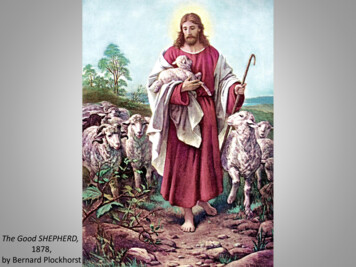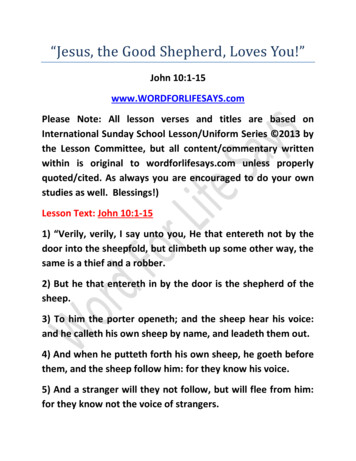
Transcription
The Good SHEPHERD,1878,by Bernard Plockhorst
Welcometo OUR 39th VIRTUAL GSP class!the GOOD SHEPHERD
20th-century stained glass depiction, Australia
WHAT DOWE KNOWABOUTCHRISTAS THE GOODSHEPHERD?Presented by Charles E.Dickson, Ph.D.
COLLECT FORTHE FOURTH SUNDAY OF EASTERO God,whose Son Jesus is the good shepherd of thy people:Grant that when we hear his voicewe may know himwho calleth us each by name,and follow where he doth lead;who, with thee and the Holy Spirit,liveth and reigneth,one God,for ever and ever.Amen.
THE GOSPEL FOR THE FOURTH SUNDAY OF EASTER:John 10:11-18 (Years A, B, and C)“I am the GOOD SHEPHERD. The GOOD SHEPHERDlays down his life for the sheep. The hired hand, whois not the SHEPHERD and does not own the sheep,sees the wolf coming and leaves the sheep and runsaway—and the wolf snatches them and scattersthem. The hired hand runs away because a hiredhand does not care for the sheep.I am the GOOD SHEPHERD. I know my own and myown know me, just as the Father knows me and Iknow the Father. And I lay down my life for thesheep. I have other sheep that do not belong to thisfold. I must bring them also, and they will listen tomy voice. So there will be one flock, one SHEPHERD.Good SHEPHERD icon,The Episcopal Churchof the Good SHEPHERD,Athens, OhioFor this reason the Father loves me, because I laydown my life in order to take it up again. No onetakes it from me, but I lay it down of my own accord.I have power to lay it down, and I have power totake it up again. I have received this command frommy Father.”
WHAT DOES THE 4TH SUNDAY OF EASTER’S GOSPEL MEAN?The passage from the Fourth Gospel is soimportant for an understanding of whoJesus of Nazareth is that it is appointed forthe Fourth Sunday of Easter in all threeyears of the Church’s lectionary.Written before the Fourth Gospel butechoing this passage is 1 Peter 2:24-25:He himself bore our sins in his body on thecross, so that, free from sins, we might livefor righteousness; by his wounds you havebeen healed. For you were going astraylike sheep, but now you have returned tothe SHEPHERD and guardian of your souls.Quite intriguing is Revelation 7:17:for the Lamb at the center of the thronewill be their SHEPHERD, and he will guidethem to springs of the water of life, andGod will wipe away every tear from theireyes.
WHAT DOES THE 4TH SUNDAY OF EASTER’S GOSPEL MEAN?The implications of Jesus’ claim to be theGOODSHEPHERDisparticularlyconsequential because rulers of Israeland Judah are called SHEPHERDS in theOld Testament since they were entrustedwith looking out for the welfare of God’speople. They were responsible fordefending them from attack, foradministering justice, for taking care ofthe poor and needy, and for makingprovisions for the worship of God.As Israel’s true SHEPHERD and Messiah,Jesus is saying that He knows us, loves us,and provides for us with the sameknowledge, love, and care that God,offers to His people. Jesus even promisesus the gift of eternal life.
WHAT DOES THE 4TH SUNDAY OF EASTER’S GOSPEL MEAN?Jesus begins His GOOD SHEPHERD discourseby describing the relationship between thesheep and the SHEPHERD and implies thatGod also knows them by name, and theyshould recognize God’s voice. This direct andpersonal relationship is therefore with a Godwho is not some far-off deity uninterested inHis people but a God who loves them andcalls them by name.Like the prophets Jesus contrasts God’s carefor people with the failure of the Jewishleaders who came before him. He exposesthem as false SHEPHERDS. Instead of caringfor God’s flock, they were thieves androbbers from whom the sheep neededprotection.Jesus insists that He came to save the sheepand to give them “abundant life.”
WHAT DOES THE 4TH SUNDAY OF EASTER’S GOSPEL MEAN?By claiming the role of the GOODSHEPHERD, Jesus was obviously puttingHimself in a position reserved for Godand even declares, “The Father and I areone.” It was a remarkable statement,and it provoked a dramatic response—the crowd took stones in order to killHim.There appeared to be no two waysabout it. Either Jesus was correct, andhe was the GOOD SHEPHERD beingopposed by some outsider sheep, or hewas a blasphemer who deserved theharshest punishment.The crowd’s violent reaction furtherillustrates the importance of thequestion that faces every person.
WHAT ABOUT THE SHEPHERD IN THE LOST SHEEP PARABLE?Images of Christ as the GOOD SHEPHERD often include a sheep onHis shoulders, as in the Parable of the Lost Sheep.In Matthew 18:12-14:What do you think? If a SHEPHERD has a hundred sheep, and one ofthem has gone astray, does he not leave the ninety-nine on themountains and go in search of the one that went astray? And if hefinds it, truly I tell you, he rejoices over it more than over the ninetynine that never went astray. So it is not the will of your Father inheaven that one of these little ones should be lost.
WHAT ABOUT THE SHEPHERD IN THE LOST SHEEP PARABLE?Similar to Matthew’s Gospel is Luke15:4-7:“Which one of you, having a hundredsheep and losing one of them, doesnot leave the ninety-nine in thewilderness and go after the one thatis lost until he finds it? When he hasfound it, he lays it on his shouldersand rejoices. And when he comeshome, he calls together his friendsand neighbors, saying to them,‘Rejoice with me, for I have found mysheep that was lost.’ Just so, I tellyou, there will be more joy in heavenover one sinner who repents thanover ninety-nine righteous personswho need no repentance.
IS THE SHEPHERD IMAGE FOUND IN EARLY CHRISTIAN ART?The image of the GOOD SHEPHERD is the most common symbolicrepresentation of Christ found in early Christian art in the Catacombsof Rome, before Christian imagery could be made explicit. The imagecontinued to be used in the centuries after Christianity was legalizedin 313.This SHEPHERD image was found frequently in Christian places ofworship before Constantine, probably not understood as a portrait ofJesus, but a symbol like others used in Early Christian art. It was themost common of the symbolic depictions of Jesus used during thepersecution of Christians under the Roman Empire, when EarlyChristian art was necessarily furtive and ambiguous.In some cases the image may have alluded to the SHEPHERD ofHermas, a popular Christian literary work of the early-to-mid 2ndcentury. In this text, a freed slave named Hermas is guided andtaught by a heavenly messenger who is dressed as a SHEPHERD. Thisstrange allegory had a great vogue in orthodox circles and was evenincluded in some versions of the New Testament.
IS THE SHEPHERD IMAGE FOUND IN EARLY CHRISTIAN ART?By about the 5th century the SHEPHERD figure more often took onthe appearance of the conventional depiction of Christ, as it haddeveloped by this time, and was given a halo and rich robes, as onthe apse mosaic (526-30) in the church of Santi Cosma e Damiano inRome.
Allegory of Christ asthe GOODSHEPHERD,3rd century.
Depiction at the Catacomb of Priscilla, Rome
4th-century depiction, Baths of Diocletian, Rome
Christ the GOOD SHEPHERD, c.425, mosaic in the Mausoleum of Galla Placidia, Ravenna, Italy.The SHEPHERD is seen clothed in golden robes with a large golden cosslike staff, and a halo. Thischange may present a change in how they wished for Christ to be represented to the peoplewho are going to see it. They wanted to see Christ like a king, not a humble person like before.All other representations of Christ before this where he was shown as a GOOD SHEPHERD are nowhere near as regal as this one.
Christ the GOOD SHEPHERD, 6th century, Basilica di Sant’Apollinare Nuovo, Ravenna, Italy
IS THE SHEPHERD IMAGE FOUND IN EARLY CHRISTIAN ART?Early Christian imagery of Christ as the GOODSHEPHERD was adopted from previous GrecoRoman images of a human figure who carries asacrificial animal, usually on its shoulders.In ancient Greek cult, kriophoros, the “rambearer,” is a figure that commemorates thesolemn sacrifice of a ram. It becomes an epithetof Hermes: Hermes Kriophoros.The supposedly Christian image was directlyborrowedfromthemucholderpagan kriophoros and it is impossible to saywhether the image was originally created withthe intention of having a Christian significance.cult image ofthe Kriophoros,c.450 BC,from Thebesin BoeotiaNot every kriophoros, even in Christian times, is Christ, the GOODSHEPHERD. A kriophoros SHEPHERD, fleeing with his flock from theattack of a wolf, can be a purely pastoral figure rather than Christ,the GOOD SHEPHERD.
Late Roman marble copyof the Kriophorosby Calamis,1st half of the5th century CE
The GOOD SHEPHERD, c.300-50,at the Catacombs of Domitilla, Rome
HOW SIGNIFICANT WERE SHEPHERDS?Being a SHEPHERD, one who cares for a flock of sheep, was acommon occupation in the ancient Mediterranean area. Since the 7thmillennium BC, humans domesticated sheep and made use of theirmeat, milk, and wool. Along with goats, cattle, and pigs, they were anintegral part of ancient Palestine’s economy.As sheep were important in the Middle Eastern economy in Biblicaltimes, it is the animal mentioned most often in Scripture. In fact, aman’s wealth was judged by the number of livestock he owned–suchas sheep, goats, cattle, donkeys, camels, and oxen. Job had 14,000sheep (Job 42:12), and the plunder taken from the Midianitesincluded 675,000 sheep (Num. 31:32). Thousands of sheep werekilled for sacrificial offerings to God. One of Jerusalem’s ten gates wascalled the Sheep Gate, near the temple where sheep were sacrificed(Neh. 3:1).Today a Christian congregation is often called the flock of a pastor,another word for SHEPHERD.
WHAT WERE A SHEPHERD'S SKILLS?In Biblical times sheep herding was hard work. The sheep neededconstant care and attention as they were not kept in fenced fields andcould wander anywhere. SHEPHERDS made sure that the sheep hadwater, pasture for food, and a safe place to sleep. They protected thesheep from predators such as wolves, lions, and bears. Every day theSHEPHERD needed to lead the flock to suitable pasture and water andcare for the sick or injured. When they travelled, the SHEPHERD led andthe sheep followed behind.As the SHEPHERD was known for his feeding and protecting the flock, thelife of the SHEPHERD was excellent preparation for a ruler who would leadGod’s people.
HOW DID THE PROPHET MICAH SEELEADERS AS SHEPHERDS?Like many of the prophets, Micah compared the leaders toSHEPHERDS.In Micah 5:4:And he shall stand and feed his flock in the strength of the LORD,in the majesty of the name of the LORD his God.And they shall live secure, for now he shall be greatto the ends of the earth;In Micah 7:14:SHEPHERD your people with your staff,the flock that belongs to you,which lives alone in a forestin the midst of a garden land;let them feed in Bashan and Gileadas in the days of old.
HOW WERE LEADERS SOMETIMES BAD SHEPHERDS?The plight of Israel without leaders is likened to sheep without aSHEPHERD in Numbers 27:17:who shall go out before them and come in before them, who shalllead them out and bring them in, so that the congregation ofthe LORD may not be like sheep without a SHEPHERD.Similarly in 1 Kings 22:17:Then Micaiah said, “I saw all Israel scattered on the mountains, likesheep that have no SHEPHERD; and the LORD said, ‘These have nomaster; let each one go home in peace.’”Later, the prophets, priests, and kings who had failed God and God’speople were condemned as SHEPHERDS who deserted or misled theflock. Written during the Babylonian Exile (597-538 BC), theseprophets condemn Israel’s leaders for their apostasy and injusticewhich had led to the plight of the people of God’s chosen nation.
HOW WERE LEADERS SOMETIMES BAD SHEPHERDS?Jeremiah announces in Jeremiah 23:2:Therefore thus says the LORD, the God of Israel, concerning theSHEPHERDs who SHEPHERD my people: It is you who have scattered myflock, and have driven them away, and you have not attended to them.So I will attend to you for your evil doings, says the LORD.Ezekiel proclaims in Ezekiel 34:2-6:Mortal, prophesy against the SHEPHERDs of Israel: prophesy, and say tothem—to the SHEPHERDS: Thus says the Lord GOD: Ah, you SHEPHERDSof Israel who have been feeding yourselves! Should not SHEPHERDS feedthe sheep? You eat the fat, you clothe yourselves with the wool, youslaughter the fatlings; but you do not feed the sheep. You have notstrengthened the weak, you have not healed the sick, you have notbound up the injured, you have not brought back the strayed, you havenot sought the lost, but with force and harshness you have ruledthem. So they were scattered, because there was no SHEPHERD; andscattered, they became food for all the wild animals. My sheep werescattered, they wandered over all the mountains and on every high hill;my sheep were scattered over all the face of the earth, with no one tosearch or seek for them.
WHO WERE THE EARLY Biblical SHEPHERDS?The first Biblical SHEPHERD is found in Genesis 4:2 in describing theoccupation of Adam and Eve’s son, Abel.Abel's Offer, 1908, by Hans Andersen Brendekilde
WHO WERE THE EARLY Biblical SHEPHERDS?Abraham, his nephew Lot, his son Isaac, his grandson Jacob, andJacob’s sons are identified as SHEPHERDS.Abraham Journeying to the Land of Canaan, 17th century, by Giovanni Benedetto Castiglione
WHO WERE THE EARLY Biblical SHEPHERDS?Moses was a SHEPHERD when God called him to lead Israel out ofEgypt (Exodus 3:1).Landscape with Moses and the Burning Bush, 1610-16, by Domenico Zampieri
WAS DAVID A SHEPHERD KING?David was also a SHEPHERD when God called him to be Israel’s king(1 Samuel 16:11ff.)David recalls this in 1 Samuel 17:34-36:But David said to Saul, “Your servant used to keep sheep for his father;and whenever a lion or a bear came, and took a lamb from the flock, Iwent after it and struck it down, rescuing the lamb from its mouth;and if it turned against me, I would catch it by the jaw, strike it down,and kill it. Your servant has killed both lions and bears; and thisuncircumcised Philistine shall be like one of them, since he has defiedthe armies of the living God.”SHEPHERDING prepared David to rule as pointed out in Ezekiel34:23-24:I will set up over them one SHEPHERD, my servant David, and he shallfeed them: he shall feed them and be their SHEPHERD. And I, the LORD,will be their God, and my servant David shall be prince among them; I,the LORD, have spoken.
David, the Future King of Israel,while a SHEPHERD at Bethlehem,19th century,John Rogers Herbert
HOW DO THE PSALMS REPRESENT GOD AS A SHEPHERD?Throughout the Psalms God is presented as Israel’s SHEPHERD andthe One who guides the people like a flock.In Psalm 28:11:Save your people and bless your inheritance; *SHEPHERD them and carry them for ever.In Psalm 80:1:Hear, O SHEPHERD of Israel, leading Joseph like a flock; *shine forth, you that are enthroned upon the cherubim.In Psalm 95:7:For he is our God, and we are the people of his pasture and the sheep ofhis hand. *Oh, that today you would hearken to his voice!The best-known example of the Bible’s SHEPHERD imagery for God isPsalm 23, the psalm appointed for GOOD SHEPHERD Sunday. In richsymbolism, this psalm movingly depicts God as the true king of Israeland SHEPHERD of God’s people.
HOW DID THE PATRIARCH JACOB SEE GOD AS A SHEPHERD?The patriarch Jacob describe God as “my SHEPHERD all my life” as wellas “the SHEPHERD, the Rock of Israel.”In Genesis 48:15:He blessed Joseph, and said,“The God before whom my ancestors Abraham and Isaac walked,the God who has been my SHEPHERD all my life to this day. . . .”In Genesis 49:24:Yet his bow remained taut,and his arms were made agileby the hands of the Mighty One of Jacob,by the name of the SHEPHERD, the Rock of Israel. . . .
HOW DID THE PROPHETS SEE GOD AS A SHEPHERD?From the idea of the SHEPHERD as a protector and leader of the flock,came the concept of God as Israel’s SHEPHERD. Jacob so addressed God inthe days just before his death (Genesis 48:15). David called God hisSHEPHERD in the well-known Psalm 23 and Asaph did in Psalm 80.Many of the prophets, including Hosea, Jeremiah, Ezekiel, Micah, Nahum,and Zechariah use SHEPHERD imagery. Even the earliest of the literaryprophets, Amos, was a SHEPHERD-turned-prophet.In Amos 3:12:Thus says the LORD: As the SHEPHERD rescues from the mouth of thelion two legs, or a piece of an ear, so shall the people of Israel who livein Samaria be rescued . . .
HOW DID THE PROPHET JEREMIAHSEE GOD AS A SHEPHERD?Jeremiah offers the assurance from God in Jeremiah 23:4-5:I will raise up SHEPHERDS over them who will SHEPHERD them, and theyshall not fear any longer, or be dismayed, nor shall any be missing, saysthe LORD.Jeremiah then speaks of God as one like a SHEPHERD who protectsHis flock in Jeremiah 31:10:Hear the word of the LORD, O nations,and declare it in the coastlands far away;say, “He who scattered Israel will gather him,and will keep him as a SHEPHERD a flock.”The Prophet Jeremiah, 1968, Marc Chagall
HOW DID THE PROPHET EZEKIEL SEE GOD AS A SHEPHERD?Like Jeremiah, Ezekiel delivers a promise from God, the True SHEPHERD, inEzekiel 34:11-12:For thus says the Lord GOD: I myself will search for my sheep, and will seek themout. As SHEPHERDS seek out their flocks when they are among their scatteredsheep, so I will seek out my sheep. I will rescue them from all the places to whichthey have been scattered on a day of clouds and thick darkness.Ezekiel completes the view of God as a SHEPHERD by describing Him as aGod who seeks out His flock and cares for it.In Ezekiel 34:14-16:I will feed them with good pasture, and the mountain heights of Israel shall betheir pasture; there they shall lie down in good grazing land, and they shall feedon rich pasture on the mountains of Israel. I myself will be the SHEPHERD of mysheep, and I will make them lie down, says the Lord GOD. I will seek the lost, and Iwill bring back the strayed, and I will bind up the injured, and I will strengthenthe weak, but the fat and the strong I will destroy. I will feed them with justice.
HOW DO THE PROPHET ISAIAH SEE GOD AS A SHEPHERD?The Prophets often use the SHEPHERD metaphor for God. Isaiah’sfamous song is often identified as speaking of Jesus, the GoodSHEPHERD.
HOW DID THE PROPHETS SEE GOD AS A SHEPHERD?Jeremiah speaks of God as one like a SHEPHERD who protects Hisflock.
HOW ARE SHEPHERDS PART OF THE CHRISTMAS STORY?Interestingly, SHEPHERDS were the first ones told of the birth of theSavior.In (Luke 2:8-10):In that region there were SHEPHERDS living in the fields, keeping watchover their flock by night. Then an angel of the Lord stood before them,and the glory of the Lord shone around them, and they wereterrified. But the angel said to them, “Do not be afraid; for see—I ambringing you good news of great joy for all the people. . . .”The story of Herod and the Wise Men has Biblical scholars bringingup SHEPHERDS in deciding where the new king would be born.In Matthew 2:6:‘And you, Bethlehem, in the land of Judah,are by no means least among the rulers of Judah;for from you shall come a rulerwho is to SHEPHERD my people Israel.’
THE BURIAL DISMISSALThe God of peace,who brought again from the deadour Lord Jesus Christ,the great Shepherd of the sheep,through the blood of the everlasting covenant:Make you perfect in every good work to do his will,working in you that which is well pleasing in his sight;through Jesus Christ,to whom be glory for ever and ever.Amen.This prayer alludes to the Benediction in Hebrews 13:20.
The End
I am the GOOD SHEPHERD. I know my own and my own know me, just as the Father knows me and I know the Father. And I lay down my life for the sheep. I have other sheep that do not belong to this fold. I must bring them also, and they will listen to my voice. So there will be one flock, one SHEPHERD. For this reason the Father loves me, because I lay










